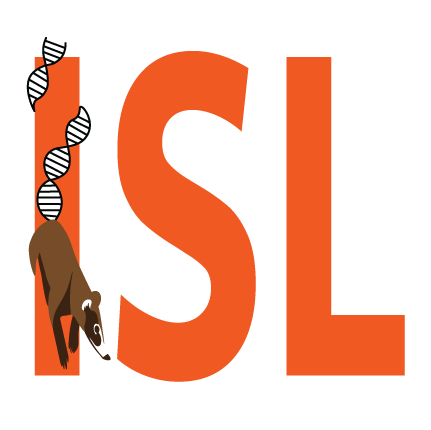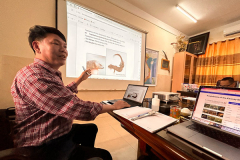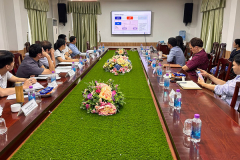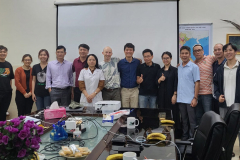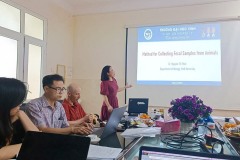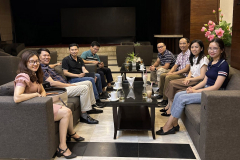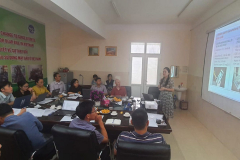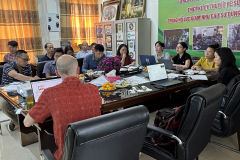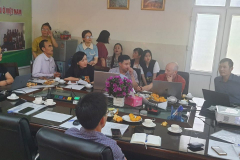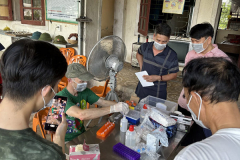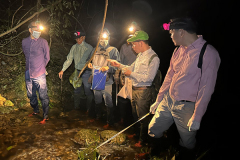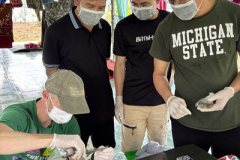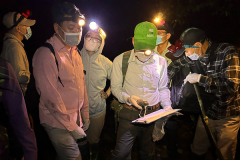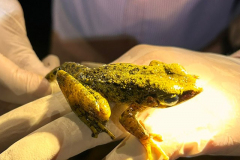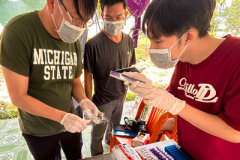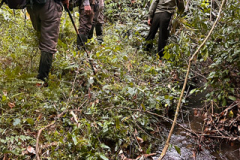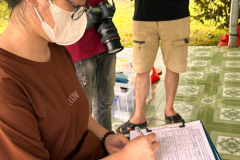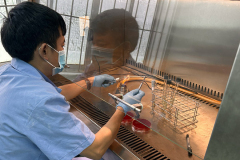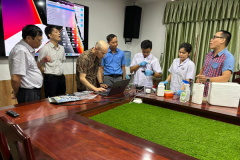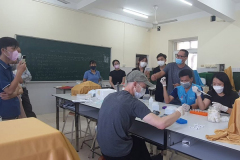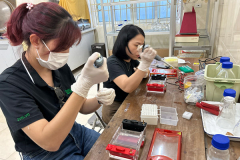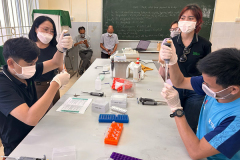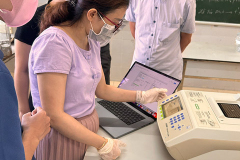ISL Vietnam
Extending along the north-south axis, and defining Vietnam’s western border with Laos and Cambodia, is the Annamite range. The Annamese Mountains host the greatest amount of terrestrial plant and animal biodiversity in the country, with especially elevated levels of endemism. This area has been a regular focus of biodiversity and watershed conservation efforts due to its topography and distance to the coast, limiting development as compared to other regions of the country. However, land conversion for agricultural purposes is common and has been expanding in concert with human demand. With such conversions come an increasing interface between domestic animals and wildlife that is sporadically monitored both in terms of disease transmission to/from wildlife, and in terms of wildlife population stability across years. Wildlife poaching is documented in the Annamite region, which is functionally difficult to protect. Some of the wildlife that occur in the Annamese Mountains are also targeted for farming to contribute to wildlife pet trade or to derive parts/products for alternative medical practices (i.e. bear bile, tiger bone glue).
The ISL is currently focused on conducting longitudinal animal health surveillance programs in the central highlands with two in-country partners – the Institute for Ecology and Conservation of Nature (IECN) at Vinh University and the Institute for Veterinary Research and Development (IVRD) based in Nha Trang. Initial projects with IECN will revolve around amphibian population monitoring, and with IVRD, pathogen exchange at the interface between domestic animals and wildlife.
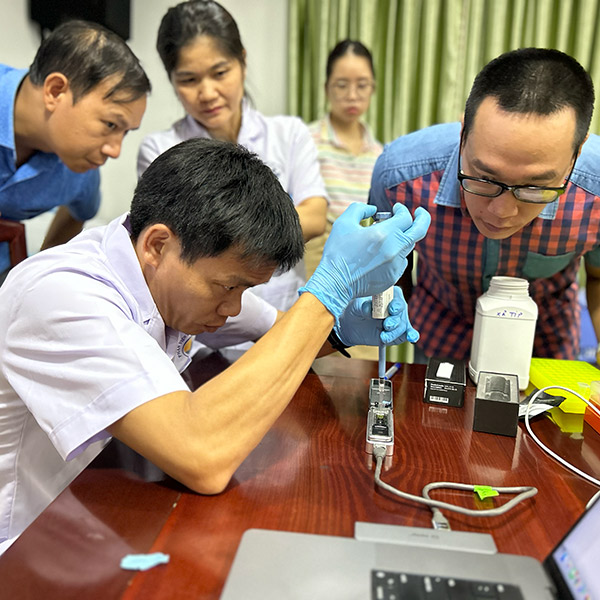
DNA sequencing demonstration at the Institute for Veterinary Research and Development, Nha Trang.
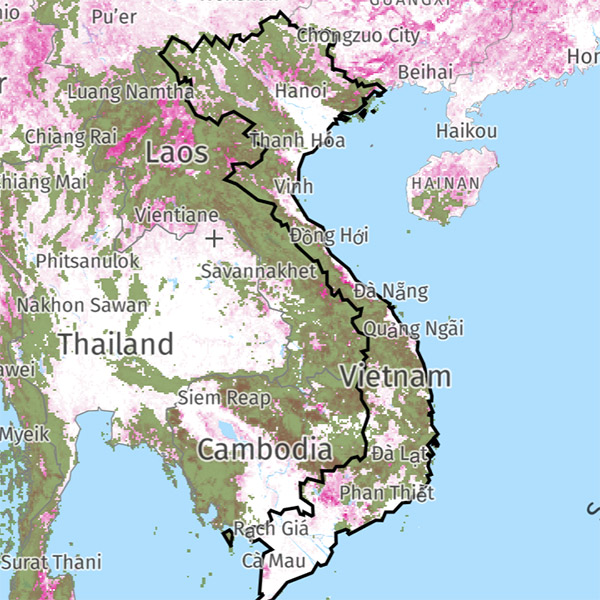
Map of Vietnam. Global Forest Watch.Primary forest (green); tree cover lost 2001 to 2022 (pink). accessed May 2024.
Ecological Monitoring
Population status of Amphibians and reptiles in Vietnam is not well studied in comparison to iconic mammals including bears, tigers, ungulates, and pangolins. Up to 18% of all known amphibians, and 28% of endemic species are threatened with extinction. Information to support conservation is often deficient and outdated and the precise cause of decline of many species is unknown; 25% of all species have not been assessed for the IUCN Red List. Exploitation for human consumption is also a threat ̣(Warkentin et al, 2009) but has not been studied in Vietnam, prior assessments instead concentrate on habitat loss and disease (Krizowski et al, 2022). Near to villages, local families may make specific expeditions of three to four hours collecting amphibians and reptiles, including juveniles and larvae, for food (Cao Tien Trung, 2018). Deeper in the forests, smaller groups of hunters, loggers and collectors of forest products frequently supplement their diet in the field with frogs and occasional reptiles collected from streams around their camp. Trade in certain reptile species, especially turtles, is well-documented (Compton & Le Hai Quang 1998, Gewiss et al 2020, Thong Pham Van et al, 2019), although there has been more focus on trade dynamics than site-level impacts of hunting (Gewiss et al 2020). Taken in aggregate, in heavily impacted areas, small-scale operations can have a significant overall effect on amphibian and reptile populations, in addition to the chronic depopulation of species that are actively targeted for sale.
The impact of such activities on overall population status and diversity relative to global threats such as pathogen spread and climate change is poorly understood. Led by the Institute for Ecology and Conservation of Nature (IECN) at Vinh University, we are carrying out routine amphibian surveys at multiple locations to generate comparative datasets that differentiate environmental impacts associated with climate change from anthropogenic disturbance. Surveyed taxa will reflect species that are subject to pressure from hunting/poaching activities, and others that are not, both dependent on access to natural habitat and stable environmental conditions. Animal survey data is paired with 1) the collection of environmental indicator variables from soil and water samples 2) non-lethal or non-invasive biological sample collection from target taxa for accurate molecular classification and pathogen screening.
Disease Surveillance
Zoonotic diseases are part of the human experience, in fact, some studies suggest that 3 out of every 4 new or emerging infectious diseases in humans and more than 6 out of every 10 recognized infectious diseases in humans can be transmitted from animals (Taylor, Latham, & Woolhouse, 2001). However, a growing number of data suggest that people can exchange infections for animals. Recent examples include Staphylococcus aureus which is resistant to methicillin, influenza A virus, Cryptosporidium parvum and Ascaris lubricoidses (Messenger et al. 2014). There have been published cases of reverse zoonoses transmission on every continent excluding Antarctica, suggesting a global disease danger. (Messenger et al. 2014). In light of worldwide growth in industrial animal production, the quick migration of people and animals and the intricate interweaving with human and animal environments, the future promises more potential for zoonoses and reverse zoonoses. Multidisciplinary project methods such as One Health are required to address these issues. To limit disease emergence and spread, a good understanding of pathogen prevalence, their ecological niche and sources of infection are required. Routine and comprehensive monitoring programs at the animal-human interface are the simplest way to quickly detect the occurrence of existing/new infectious agents in animal populations.
We are working with the Institute of Veterinary Research and Development of central Vietnam (IVRD) to create sampling and communication networks for long-term monitoring of pathogenic agents of animals in 13 provinces throughout the South-Central and Highlands of Vietnam. From local and regional veterinary networks both passive and and active sampling programs will produce an estimated 3000 biological samples for screening of target pathogens and parasites. Screening, isolation, sequencing, and characterization will allow us to monitor:
- Prevalence
- Host Specificity
- Host Pathogen Exchange
- Pathogen Genetic Variation
- Pathogen Evolution
Targets Overview
| Porcine reproductive and respiratory syndrome virus (PRRSV) causes acute infectious disease, resulting in a significant economic impact on the swine industry. In the United States alone, the economic losses caused by PRRS amount to more than 660 million US dollars every year (Kikutiet al., 2021). PRRS was first described in 2007 in Vietnam. PRRS is one of the major endemic outbreaks in Vietnam in recent years. It brought not only damage to pig farming but also huge socio-economic damage to Vietnam (Zhang and Kono, 2012). | Streptococcus suis and Leptospira are two notoriously known zoonotic pathogens that may cause diseases in pigs, cattle as well as other domestic and wild animals. While Streptococcus suis mostly originates from pigs (Hoa et al. 2011), Leptospira has been found in a wider range of animals such as pigs, cattle, dogs, cats and rodents (Mai et al. 2021). These pathogens can cause acute and/or chronic diseases not only for animals but also for humans, especially, those who have occupational contact with animals and/or their products, such as farmers, abattoir workers and butchers (Lun et al., 2007). | In Vietnam, there are many diseases transmitted between humans and animals, among them, parasitic diseases are common and play important roles in human and veterinary medicine. For example, helminthic diseases (Clonorchiasis and Opisthorchiasis), Porcine cysticercosis and Gnathostomiasis. These diseases have complex developmental life cycles with the involvement of one or more vectors. Therefore, in practice, these diseases are difficult to control and can cause huge losses to the community (Nguyen Van Thoai, 2015, Nguyen Van Thoai, 2022). |
2021 – 2022 Meetings & Project Planning With Local Partners
Objectives were established for working with two in country partners, the Institute for Ecology and Conservation of Nature (IECN) at Vinh University and the Institute of Veterinary Research and Development (IVRD). Each has unique strengths and needs for capacity associated with conducting One Health surveillance programs throughout the Central Highlands.
IVRD Objectives: Aim 1: Routine sample acquisition throughout Vietnam’s Central Highlands. Aim 2: Targeted parasite/pathogen testing & in-house molecular characterization. Aim 3: Improve IVRD’s capacity to contribute new parasite and pathogen records to international genome sequence data repositories. IVRD Map (right): Sampling sites (yellow), national parks and wildlife rehabilitation reserves (green) | 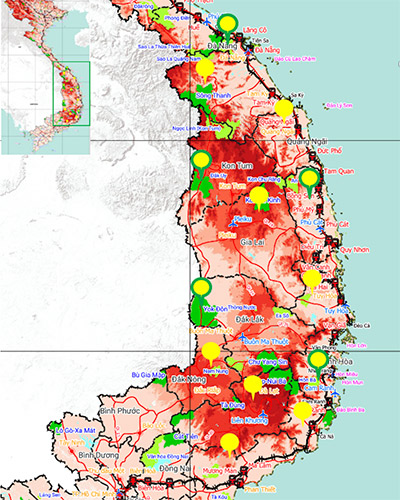 |
IECN Objective: Aim: Survey herpetofauna population trends in the Annamite Mountain Range in conjunction with environmental monitoring
IECN Map (right): Sampling sites (yellow) | 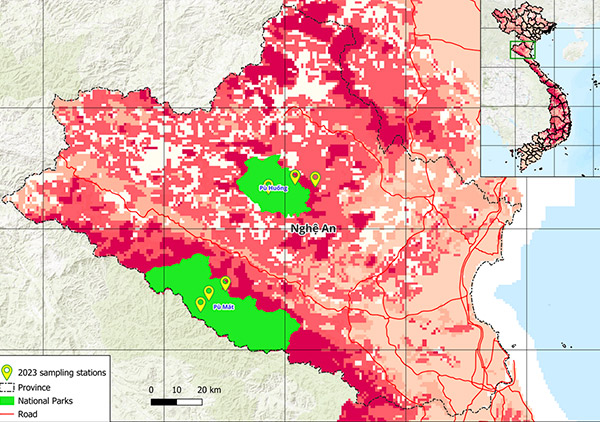 |
Details surrounding subsequent phases will be provided as they are incorporated into the ISL Vietnam work plan. Tentatively,
- Phase III: Increasing laboratory throughput with automation tools
- Phase IV: Expanding the in-country partner network and communication system
Points of Contact
Dr. Cao Tien Trung
Director, Institute of Biology, Chemistry and Environment at Vinh University
Dr. Vu Khac Hung
Director, Institute for Veterinary Research and Development
Ta Van Tuan
Director, Action on Poverty Vietnam
Gideon Erkenswick, Ph.D.
Senior Research Scientist, Field Projects International
